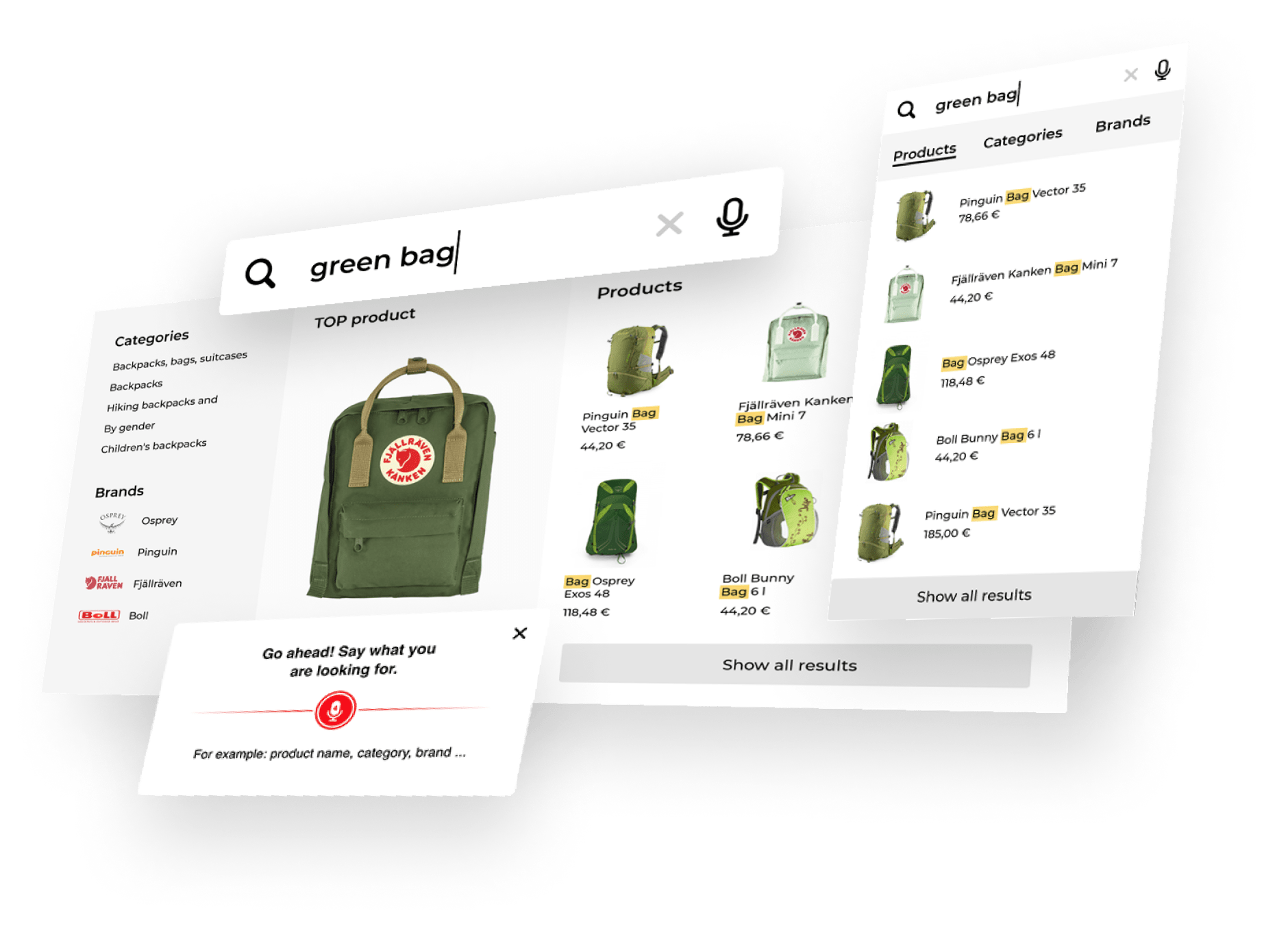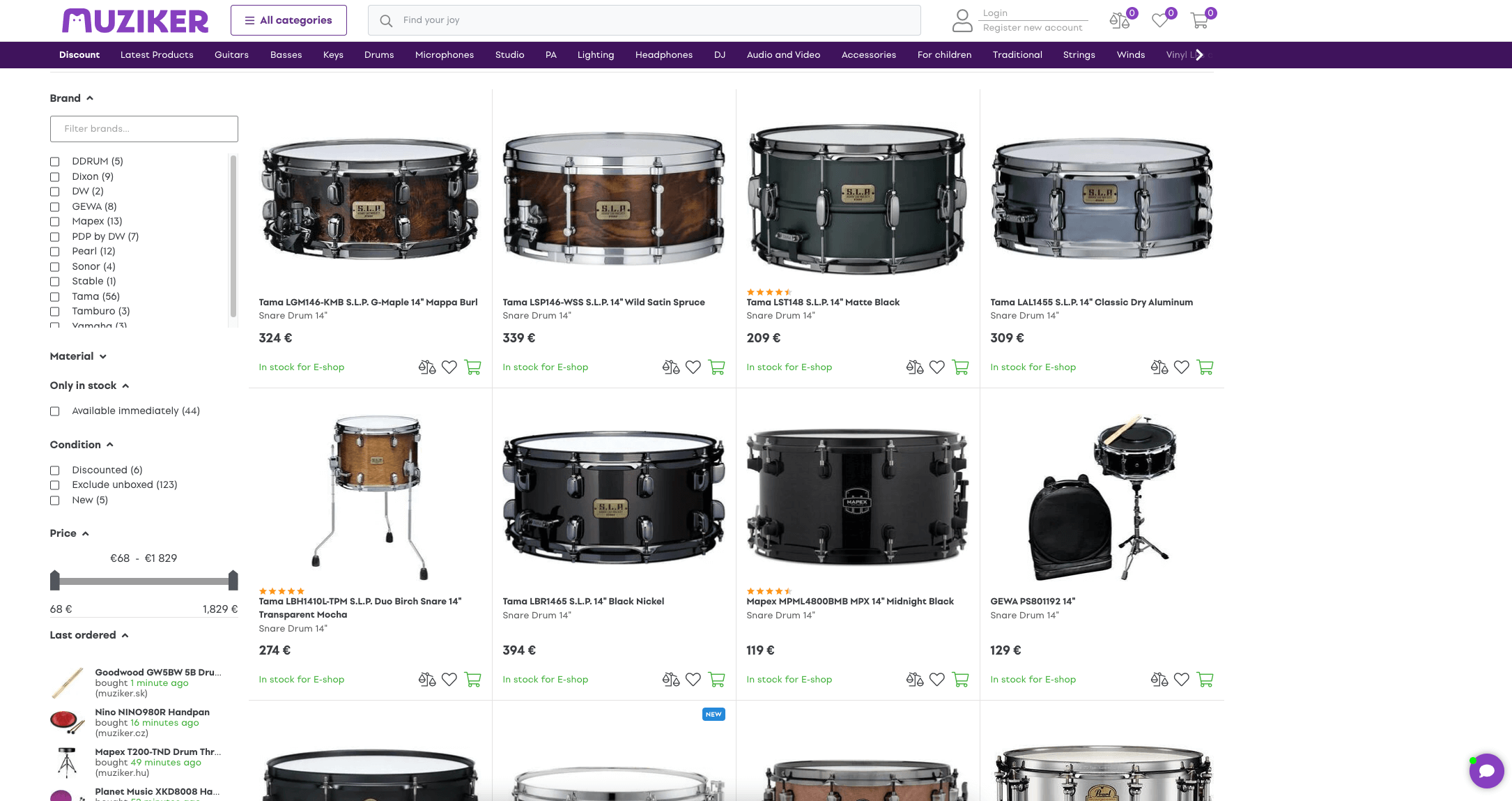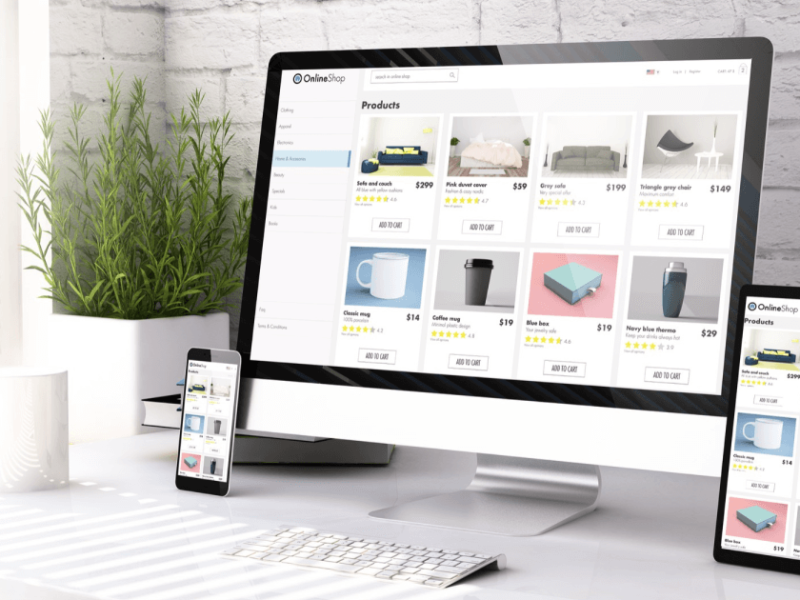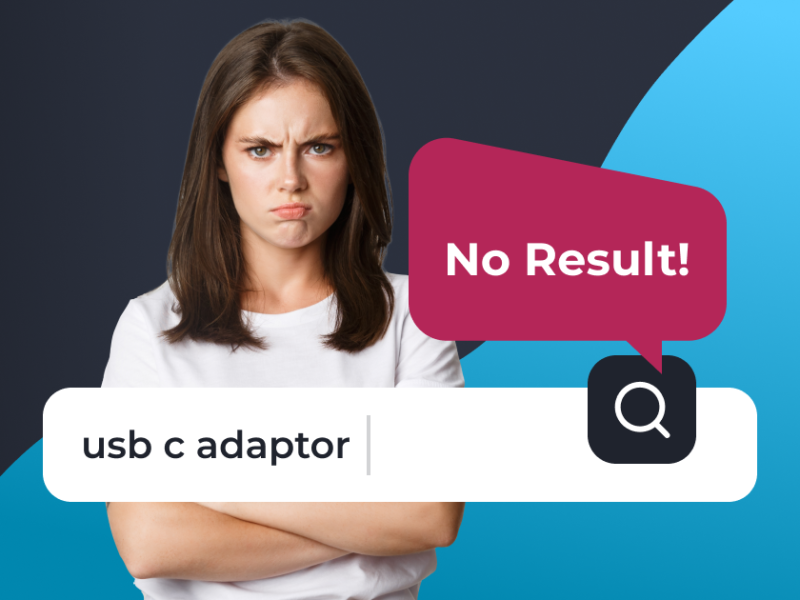- Introduction
- What is faceted filtering?
- Definition of faceting filtering
- Difference between faceted search and filters
- Benefits of using filtering for product discovery
- Use cases for faceted filters
- How to use faceted filters in your business
- How to integrate filters into your website
- How to configure filters to match your branding
- What should facet filtering contain?
- How to pick a facet-searching solution
- 1. Stay with the default filtering
- 2. Ask for custom-made search engine filters
- 3. Use a third-party solution provider
- Conclusion
- Frequently asked questions
Introduction
In an era of fierce competition in e-commerce, offering your customers a smooth, user-friendly shopping experience is more important than ever. Simply – if people can’t find what they are looking for easily on your e-commerce website, they won’t think twice about going elsewhere. Online businesses should provide a search that can guide the customers to exactly the product they need while keeping user engagement high.
While this might be a pretty difficult thing to do for a regular keyword-based search, how about using faceted filtering in your store instead?
This is a feature you should be using in 2022, as relevant facets can help your customers find the products they’re looking for faster and easier. Your shoppers can quickly nab the items they want, boosting their happiness, user engagement, and revenue.
However, according to Baymard, only 43% of top e-commerce sites offer all five filter types that they consider essential.
In this blog post, we’ll discuss what a search facet is and how it can boost your search experience and user engagement. We’ll also give you tips on leveraging it in your e-commerce store so you can reach your business KPIs. Let’s get started!

What is faceted filtering?
Faceted filtering is a search technique where users refine results by applying filters based on specific attributes or categories of the items, such as size, color, or brand.
Definition of faceting filtering
Remember when we used a phone book to find the company’s phone number we needed to contact? Sometimes, it felt like searching for a needle in a haystack. Well, looking for an item we want to buy using the regular website search can feel pretty similar, especially if the store has a vast product catalog. Okay, most search engines have simple, built-in basic filters through which users can lower the number of search results, but those are still only working around broad categories – for example, store location or brand name. And that doesn’t exactly offer a spectacular online shopping experience or help shoppers match their search intent with the ideal item.
The good news is that now, you can find plenty of far more sophisticated search tools to help your users find the information they want and eliminate or minimize bounce rates. Faceted filtering or faceted navigation is one of those tools.
Faceted search allows you to refine and narrow down the number of search results by picking one, three, or several item criteria or facets. The search engine does this by using the metadata product attributes you have set (called search facet) and then matching them with the search terms and filters the user picked.
Unlike regular searches, a faceted search also allows users to specify multiple product characteristics simultaneously, where you can only employ one filter at a time.
Difference between faceted search and filters
Before we explain how faceted search works in detail, there’s one thing we need to set straight – a search facet and filter are not the same, though they have a very similar job.
Both filters and facets help users narrow down their searches, especially if there are a lot of results for what the user is searching for. The difference is that filters work more as general categories that help shoppers pick the product type they are interested in (like “Women’s clothes”). Facets, meanwhile, are used as criteria that shoppers can use to find an item with specific traits (like color or size).
So basically, filters are related to broad and general categories, while facets describe an item’s details. Another difference is that while you can only pick one filter at a time, you can choose as many facets to narrow your search results as needed – and during one search. All that makes faceted search far more convenient for regular shoppers – especially those who don’t want to browse through several pages with a wide range of products.
Benefits of using filtering for product discovery
After all, who has enough time and patience to check all 9000 pairs of shoes or 15000 types of smartphones? There’s actually a far bigger chance here that a tired and overwhelmed customer will simply give up on finding that pair of shoes they need for the wedding party and abandon their shopping cart.
But if the search facet inside your browser can gently guide them to exactly that pair of shoes that match all of the shopper’s requirements, your chances of convincing them to make the purchase are growing tremendously – and that’s one of the most significant benefits of using faceted filtering.
But not the only one:
- Users can filter items based on specific qualities to eliminate irrelevant items from the listing. For example, if they are looking for a wool coat, there’s not much point in showing the results for cotton or polyester.
- Customers don’t need multiple searches to find items that match their desired characteristics – they can add as many facets to the search engine as they want.
- A faceted search interface can help showcase the variety of options available within your product catalog and encourage the customers to browse your offer.
- Facet filtering can also prevent overwhelming the customer as they can narrow the search results to the most relevant products and not have to look through hundreds of them.
Overall results? Much higher customer satisfaction as they know the search engine will help them find what they want to buy without wasting their time – which directly translates into better conversion rates for you. This type of search can work especially well on mobile devices.
Rather than force your users to change their search query multiple times through the not-necessarily-convenient screen keyboard, they can just tap on the filters and choose the ones that match their needs. As 79% of smartphone users have made a purchase online using their mobile devices in the last six months, not taking advantage of this opportunity would be a big mistake.
Use cases for faceted filters
Now for a bit more practical example of how faceted search works.
I recently looked on one major online marketplace for a sleeveless down jacket for a mountain trip. There were thousands of results for the keywords. But here comes the faceting filtering search assistant:
- Do you want a completely new vest, or can it be used? Or would you be okay with buying a new but slightly damaged product sold for half the price?
- What size are you looking for?
- Where should the vest be produced?
- What color, shell material, and inside material do you want?
- Would you like a short vest or a mid-length one?
- Are you looking for a sport-type vest or something more elegant?
Feels like I was browsing the store with an experienced shop assistant rather than just a regular search engine, right? The marketplace might have thousands of items coming from hundreds of stores, but thanks to an intelligent faceting filtering engine, I could narrow down the results to a few stores with the kind of vest I was looking for. Exactly like when you describe an item you want to buy to a shopping assistant, and they guide you to the product that matches your description the most – and can even tell you that this one dress is currently discounted.
How to use faceted filters in your business
The primary purpose of using faceted navigation in your store is to boost your customers’ online shopping experience by allowing them to locate the type of product they are interested in a matter of seconds. But if you want the faceted search to work as intended and delight your shoppers rather than upset them, then there are a few things you need to know before adding the filters to your search engine.
How to integrate filters into your website
For the facet filters to work, they need data – as much as possible (and relevant). So before you start creating and adding facets to your search engine, you first need to look at the products you offer and consider what qualities your customers are most likely looking for when browsing your products.
Search analytics is a great way to do it. By tracking keywords and metrics, you can learn how users interact with your content and what facets could be added to suit their needs better. For example, shoppers might find facets like screen size, camera, battery capacity, and so on helpful when looking for a new smartphone. But in categories such as clothes and shoes, they are far more likely to be interested in color, size, material, or whether the product is ethically made.
The advanced search tools inside the faceted search engine can also tell you much about what your shoppers are looking for. Using search analytics, you find out how your customers use your search engine and then optimize the facets to enhance the search relevance and match the user intent even more.
How to configure filters to match your branding
What’s even better about the faceted search is that you can customize the facets to reflect your brand and the products you sell and even nudge your customers to look at your promoted items.
As the user navigates your site and selects facets, they can see your store’s options. That way, facets can bring users’ attention to brands, styles, sizes, and other attributes they otherwise would have missed – and convince them to search for other products using the new knowledge.
A good example here is creating thematic filters matching your brand. In this section, you group products that match certain criteria or fit specific situations – “Holiday wear,” “Ethically made,” and so on. Those work equally well for people who know exactly what they want and for more passive browsers just starting and looking for a theme that resonates with them. By picking one of the thematic filters, shoppers can quickly find all items that match the chosen category – and, for example, create their beauty travel set out of the items in the “Travel essentials” product category.
What should facet filtering contain?
Once you have noted which facets would be the most useful for your customers and organized them into categories, it’s time to handle a few more technical things. Since faceted filtering relies on the product attributes and filters you set up in your store to help your customers find what they need, you have to put more effort into creating and setting up the filters.
First, what should you add to the filtering facet to make it work properly?
- Name of the filter
- Type of the filter
- To what product category does the filter belong (so it would only show with relevant categories)
- How will you show the filter options if you have a large number of them (all of them at once or maybe as a scrolled menu)
- Will there be a “reset” option where your users can unselect all values and start from the beginning of a back arrow to allow the customers to go back one level
- The number of products that will be available after each value
Another thing to consider is where exactly you will display the filtering search bar – at the top of the website or maybe on the left side of the screen. The top of the website might be more convenient for some visitors, but here, you need to make sure the menu doesn’t disappear even when the mouse cursor moves. Meanwhile, the vertical sidebar gives you far more space for filters, and it’s also where many users are looking for search options, so it might be a more intuitive place for giving them facet options.

How to pick a facet-searching solution
The facet filtering feature might sound like something your e-commerce brand and the customer might find handy, but aren’t they pretty daunting to set up? Especially if you have 5000 products or so? So maybe it would be better to stay by your default search engine? Or perhaps there is an app for adding faceted search to your store?
Let’s look at the three main options you have here:
1. Stay with the default filtering
Looking at the amount of work you might have to do when optimizing your store for faceted filtering, you might decide it’s better to keep your regular, simple filters. And if you don’t have hundreds of products in your store, you may not need the faceted filtering right now.
But the more products you sell, the more important it would be to give your shoppers a smooth way to do their search the way they want it through facet filters. Plus, despite the work involved, using faceted search is a great way to boost your sales as 39% of purchasers are influenced by a relevant search – and facets are all about relevance.
Compared to regular search engines, the faceted search can be tailored to match your brand and enable your shoppers to customize their searches to suit their needs. This is yet another place where you can increase sales since 48% of consumers spend more when their user experience is personalized.
2. Ask for custom-made search engine filters
The second option is to ask a development company to create the faceted filters for your brand and then integrate them with your store. As a benefit, you can ask the development company to tailor the filters, navigation, and other search features to your brand without having to do the technical work yourself. If you have thousands of products in your store or need particular features in your search engine, this option might be worth checking out.
However, you must be aware that a custom facet search engine will cost quite a bit, depending on the number of filters and other features you need to add.
3. Use a third-party solution provider
Those who want to benefit from faceted search but do not want to pay a developer to set the filters would be best off using a third-party search engine app. While you still need to put some effort into organizing your product attributes into filters and categories, it’s far easier to do so with a dedicated product search engine as you already have all the tools and features inside the app; you just need to configure it to suit your needs.
What’s more, inside solutions like Luigi’s Box, you can find far more features than just optimizing your search engine for facets – integrations, product recommendations, store analytics, dynamic filtering, and more are ready to be used. Luigi’s Box is also powered by artificial intelligence that keeps getting smarter with time – the more it interacts with customers, the better product recommendations it can give.
Before purchasing a paid plan, you can also test out the trial version of the search engine platform to ensure it works as you need. You get almost all the benefits of a custom search box at a fraction of the cost of working with a developer.
How to decide which facet search platform out of the many would be the best for you? Here are a few questions you can ask yourself to find out:
- What are your primary business needs and goals for the new search engine?
- What type of data do you need to search through? How large is your data set?
- How intuitive is the user interface? How easy would it be for users to filter their searches by different facets using those apps?
- What is your budget? The pricing range of different facet search solutions can be pretty wide depending on what features they have inside, so you need to carefully compare the pricing to find the app that won’t break your budget.
- What advanced features does each platform have (for example, advanced search, artificial intelligence, product recommendations, or natural language processing)
- Does the faceted search interface work smoothly on mobile devices as well?
- Customization options: Can the facet options be customized to meet the specific needs of your business?
Once you’ve considered these factors, you should be able to narrow down your options and choose the best facet search solution for your business.
Conclusion
Having a simple input field as a search option isn’t enough to provide your customers with an outstanding online shopping experience – especially as they rarely know exactly what they’re looking for. And showing them a wide variety of shoes or makeup products that more or less match their search query will likely only scare them off.
If you’re looking to improve your user experience in your shop, then faceted browsing is one of the best things you can use for the goal. Facets allow shoppers to customize their search and effectively narrow the number of products they have to choose from until they have found their ideal match.
And the easier you make it to find the product the customer wants, the higher the chance they will click on the “Buy” button. So why not give your customers their 24/7 personal shopping assistant through faceted search?
Frequently asked questions
What is a facet filter?
A facet filter is a search engine tool that allows users to see only relevant filters for their search query and refine their search results by applying multiple detailed filters to their search. That way, the search engine can match the user intent with the correct product much faster – and with far less clicking on their part.
What is the difference between faceted search and filtering?
Filters work as general categories you can choose while browsing the store, like “Accessories” or “Women’s clothes.” Meanwhile, a faceted search uses product attributes to help the customer find the best match – size, color, and sleeve length are examples of facets. A faceted search also makes sure that only relevant filters are shown with each search result, while the filters are the same regardless of what you searched for.
How to start using faceted filters?
The fastest way is using a third-party facet search engine that will allow online businesses to quickly add the filters to their stores and configure them to give their customers a smooth online shopping experience. But before that, you need to spend a bit of time learning what facets would be most beneficial for your customers – otherwise, they might not even be using those.
What is the best provider for faceted filters?
You might want to try out Luigi Box, as it’s one of the most popular e-commerce search engines for online businesses. Besides the faceted search feature, you can also find an autocomplete with a typo correction feature, a product recommender box, comprehensive analytics, and a few more valuable tools that can help you further grow your e-commerce business, minimize bounce rates, and reach your business KPIs. All for continuous improvement!
Barbora does magic with words in Luigi's Box as a product marketing specialist. She got into writing while studying at university as a volunteer for various civic associations. Besides being part of Luigi's Box marketing team, she co-organizes the TEDxBratislava conference, where she cares about marketing and PR.
More blog posts from this author



























![E-Commerce Website Development Steps in 2024 [Checklist]](https://www.luigisbox.com/app/uploads/2022/08/cover-ecommerce-800x600.png)
![[Explained] Trendings](https://www.luigisbox.com/app/uploads/2021/09/trendings-800x600.png)
![[Explained] Custom Keywords](https://www.luigisbox.com/app/uploads/2022/08/custom-keywords-2-1-800x600.jpg)
![[Explained] Synonyms and Synonym Recommendations](https://www.luigisbox.com/app/uploads/2022/10/synonyms-exaplained-800x600.jpeg)
![[Explained] Boosted Items and Boosted Terms](https://www.luigisbox.com/app/uploads/2022/08/lbx-boosted-cover-1-800x600.jpeg)







